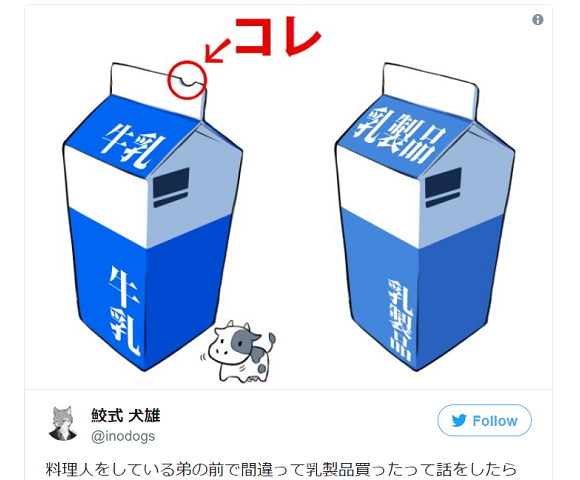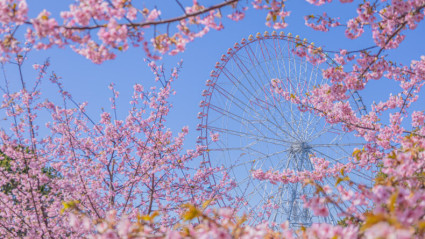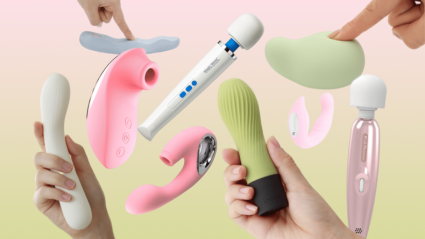Going to buy milk at the store in Japan can be a little tricky for anyone who doesn't read Japanese. See, while all those paper cartons with pictures of white, creamy liquids on them night look like moo juice, that’s not necessarily the case.
Generally right next to the milk on the shelves of Japanese grocery and convenience stores you can find a selection of other dairy-based concoctions. These could be milk mixed with butter, dry milk, water, coffee, or fruit flavorings, potentially giving you something richer, thinner, or quite different-tasting than the milk you actually want to buy.
If you can read kanji, Japan’s non-phonetic writing system, you can differentiate between gyunyu/牛乳 milk, and nyuseihin/乳製品, as the not-quite-milk products are called, by reading the text printed on the carton. But even if Japanese is all Greek to you, there’s a way to tell them apart, as explained by Japanese Twitter user @inodogs in the above diagram.
Sometimes even native Japanese shoppers sometimes grab the wrong carton by mistake, and @inodogs was telling his younger brother, a professional chef, about a time when he ended up with nyuseihin when he wanted gyunyu. So his brother clued him in on a little-known secret: if the carton has a little piece cut out of its top ridge, as shown in the red circle in @imodog’s tweet, that means it’s ordinary milk/gyunyu.
This revelation sent shockwaves through Japanese Twitter, with tens of thousands of excited, newly-informed individuals helping to spread the world with likes and retweets. But while this knowledge is a boon to foreigners struggling with kanji or people of any nationality who simply aren’t paying attention, the cutout isn’t originally for their benefit. Instead, it’s there to help blind or vision-impaired shoppers find milk, as part of an initiative that was started in early 2000.
It’s worth noting that not every milk producer in Japan conforms to this standard. But if you’re at the store and do see a carton with a piece missing from the top, you can be sure it’s milk, even if you’ve got no idea what the packaging says.
Source: IT Media
Read more stories from SoraNews24.
-- After a long dog day, treat your pet to a glass of fresh goat’s milk from this Japanese dairy
-- Get a taste of Japan’s past NOW, with these retro snacks and sweets at Tokyo department store
-- We put a can of condensed milk in a pressure cooker and the results are sweet and delightful!
- External Link
- https://en.rocketnews24.com/2017/10/31/how-to-buy-milk-at-the-store-in-japan-even-if-you-dont-read-or-speak-any-japanese/
 Take our user survey and make your voice heard.
Take our user survey and make your voice heard.















24 Comments
Login to comment
RichardPearce
I've had my wife tell me to 'grab some milk' (and other ingredients) while shopping in Brazil (Portuguese), Hungary, South Africa, and, yes, Japan. No, don't read or speak anything other than English, no, didn't bother trying to find someone who could speak English, or crack a dictionary. And no, never grabbed anything but milk (part fat, specifically) or whatever else she asked for after a couple minutes of looking, because the economics and psychology of marketing has gone global. And if you understand that the same things are going to be grouped together in the food stores no matter what continent, or what language, in the same basic layout, you can get to the right aisle, the right set of shelves, the right shelf, and finally the right product, even if you can't read the signs, labels, or packaging.
Jay Que
What really helped me (despite my years of study) was using the google translation app where you take a photo and it instantly translates it as you look at it through the phone, it was so helpful and amazing.
pacint
Kore just means here in the pic. ;)
nandakandamanda
The original article was for Japanese people themselves who sometimes mistakenly buy 'milk product' instead of straight milk, even though they CAN read the writing. That's why it says 'Here' in Japanese, "コレ".
In other words it's not just for illiterates like us non-native speakers.
pacint
it’s there to help blind or vision-impaired shoppers find milk
Still don't work for people who need low-fat due to health reason, etc.
Strangerland
Ok.... and? I'm not seeing any relevance in this comment to anything I've posted.
No, they can look at the tab that is cut out, as described in this article. It's actually quite easy once you know about it.
All I know is what it says in the article:
pacint
Bingo, blind people are like non-japanese speakers, neither can read the printed words.
Yet, there is braille.
Rest has to figure it out the hard way?
Btw, is the cut indicative of low fat, percentage, etc?
Strangerland
Why would blind people be feeling the body for a cutout that is on the top? That makes no sense.
Strangerland
From the article:
One part of cartons has changed, and that's what this article is about.
When I first came here, I bought drinkable yogurt as it looked like milk, and subsequently went on to ruin what had until that moment been a perfectly fine bowl of cereal.
I guarantee that others have also mistakenly bought items they thought were milk, that later turned out not to be.. And you know what, had I read this article first, I could have been spared that mistake.
Well actually, no I wouldn't, as I came here before they started doing this. But, this article isn't for me, as I can also read both 'milk' and 'milk product'.
The 'few' guys and girls who can't? The overwhelming majority of the world cannot read Japanese. This article isn't for those who can, it's for those who can't.
pacint
BTW where do you touch a carton usually on the body, you won't feel/touch along the top.
Just propaganda that don't relate to real life.
pacint
Milk cartons haven't changed much since they were introduced decades ago.
Writing on the outside varies between locations worldwide yet most people globally got zero probs identifying contents?
Sorry for the few guys/gals who cannot? You among them?
Strangerland
You're all over the place on this. You said you hate articles like this because of stuff you did 40 years ago in other countries. I pointed out that this article is current. It has nothing to do with whether someone is capable or not, I simply pointed out that right now in those countries they are using mostly the same alphabet as the English alphabet, and therefore people can use dictionaries, that do exist at this point in time, to figure out if something is milk or not, whereas in Japan a dictionary is not going to help most people.
This article is helpful for those that just want to know which one is milk, quickly and easily.
Or, now that you've read this article, you could just look for the little tab that has been cut out of the top of the milk.
pacint
Heck, using my keitai plus Google translate I can take a pic and have instant translation to any language?
Not that it is needed.
Mizuame
The one to avoid is "Reconstituted Milk" (加工乳). Made up to imitate fresh milk, taste is terrible.
pacint
Strangerland?
So people now are less capable than us older folks?
My Son disagrees.
philly1
That was supposed to be "in the milk" not "mild."
philly1
It would also be helpful to indicate where to look for percentage of butter fat. That helps to distinguish between levels of cream in the mild and what might or might not be suitable for coffee cream. There's a lot to learn.
As for not being a completely helpless mess, it's those first days when you're jet lagged and more easily confused that this is most helpful. Also, many short-term travelers often have limited budgets. When you're tired and hungry and (quite understandably) confused it's no fun picking up the wrong thing. Perhaps ditching the disdain for compassion is more helpful.
Strangerland
This article isn’t talking about the past. It’s talking about now.
pacint
Dictionary?
I have travelled this ball of dirt for 40+yrs, you know the time prior to the net, etc. There was no assistance.
Strangerland
Not really. In those countries if you’re not sure whether or not it’s milk, you can open up a dictionary. Try doing that here.
pacint
Hate articles like this one.
How to buy milk in Spain, Greece, Germany, etc same problem different country, yet the solution is he same.
Dan Lewis
Or, if you're going to be here for more than a few months, you could take some time to study a bit and not be a completely helpless mess.